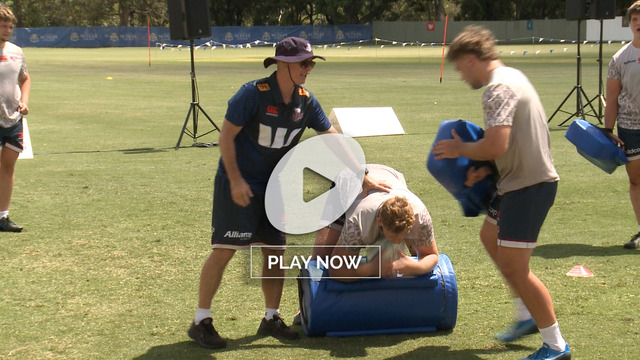The new breakdown guidelines first issued in June 2020, have produced a glut of lightning-quick (one to three second) ball in competitions all over the world. So much so, that the abbreviation “LQB” has already passed into mainstream usage in commentary on the game.
For the attack, those guidelines required ball-carriers to make no more than one movement on the ground after being tackled, and support players to remain on their feet and not ‘seal off’ by lying on top of the tackled player.
For the defence, tacklers have been required to remove themselves from the path of the cleanout post-haste, before any poach of the ball can be rewarded.
Contestants have been asked to support their own bodyweight, and attack the ball directly rather than the space behind the ball-carrier. They need to get a clearly-visible ‘lift’ on the pill.
By and large, it has made the resolution of the tackle contest far quicker than before, and that means less time for both sides to regroup before the ball is ready to be played.
That has also impacted the balance of the relationship between play-making and support at the ruck. Support at the ruck has become paramount, so play-makers have to be prepared to get stuck in and get their hands dirty more often, rather than reserving themselves for the next play automatically.
The Australian number 10 Quade Cooper always used to be known for his moments of play-making magic in his previous incarnation in Test rugby. During his renaissance at the age of 33 in the 2021 Rugby Championship, it was his willingness to multi-task which stood out.
With ruck ball being recycled so much more quickly, it frequently falls to the passer to re-ruck over the player to whom he has just delivered the ball. That is the new form of rugby economy at the cleanout:

In this example from the first game between Australia and Argentina, Cooper passes from the base to number 14 Andrew Kellaway, then follows across field to become the first or second support player at the ruck, rather than running in behind to become the play-maker on next phase.
He has to be prepared for a major contest too. Quade is tracking across field on a collision course with Julian Montoya, the Pumas hooker who won the most turnovers on the ground in the whole of the tournament. This represents a significant break in the flow chart of activity for a first five-eighth, or outside half between phases: instead of Pass> Drop to play-maker, it is as likely to be: Pass> Re-ruck> Regenerate.
This is a longer sequence from the second half of the same game. Cooper ships the ball on to his captain Michael Hooper and sticks his head in as the first support player at the resultant ruck.
Play-making devolves to the number 9 Nic White on the next two phases, with first a run by number 6 Rob Leota and then a clean break by prop Taniela Tupou sustaining momentum for the attack.
Here is a more complex and varied example from the second Rugby Championship game between the Wallabies and the Springboks:
Second five- eighth Samu Kerevi is used up on the first phase from an attacking scrum. Scrum-half Tate McDermott takes the ball up on the second play, with Quade Cooper plugging in as the second man in ruck support. That means all of the three main play-makers have been used up in contact in the first two phases, and play now has to be made by someone else on third phase:

Kerevi has regenerated sufficiently to make the call for a short-side foray, but the essential passing work is done by number 7 Hooper from the base, replacement loose-head prop Angus Bell at first receiver and his brother in arms Taniela Tupou outside him. It is a terrific ‘no-look’ pass from the ‘Tongan Thor’ which sends left wing Marika Koroibete in for the try, with replacement hooker Fereti Kaitu’u providing ultimate width out on the left side-line.
Summary
The new ruck guidelines have accelerated the blurring of boundaries between ball-winners and ball-users, contact ‘grunts’ and mercurial play-makers. In the new breakdown economy, pass-and-move can now as easily be pass-and-ruck, and that may mean a number 10 having to learn to clean out a specialist poacher on the ground. Other players have to be ready to fill in the gaps on next phase, even with all of the primary attacking ‘creators’ absorbed in the contact zone.













.jpg)
.jpg)





_no_button.jpg)

